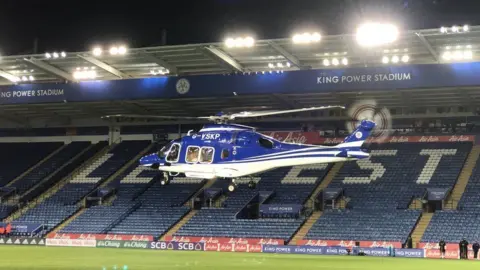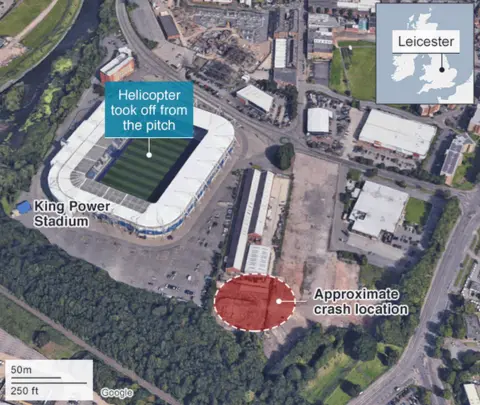 Getty Images/Facebook/Instagram
Getty Images/Facebook/InstagramAn inspector who investigated the fatal helicopter crash outside Leicester City’s stadium in 2018 said delays from the Covid pandemic was one factor that led to a final report being published almost five years later.
The inquest, which began on 13 January, is looking into the deaths of Foxes chairman Vichai Srivaddhanaprabha, fellow passengers Kaveporn Punpare and Nusara Suknamai, pilot Eric Swaffer and his partner Izabela Roza Lechowicz.
Mark Jarvis, principal inspector for the Air Accidents Investigation Branch (AAIB), has been giving evidence to the inquest at Leicester City Hall on Monday.
He said delays resulting from the pandemic – as well as feedback from the AAIB’s Italian counterparts – were major factors in the final report’s publication being heavily delayed.
Mr Jarvis previously told the inquest his conclusions of how the tail rotor duplex bearing failed and caused the helicopter to enter an uncontrolled spin on 27 October 2018.
On Monday, Mr Jarvis talked the jury through the various safety recommendations given to the European Union Aviation Safety Agency (EASA), made by the AAIB in its final report, published in September 2023.
He also gave a timeline of the final report’s creation.
‘Significant delays’
The AAIB provided initial findings in the form of special bulletins to the wider aviation community soon after the crash, Mr Jarvis said.
In late 2020, a new design of the duplex bearing was introduced, he added.
Mr Jarvis told the inquest the AAIB carried out 17 tests of duplex bearings between late 2018 and December 2020, six of which lasted between 44 and 54 days.
Mr Jarvis explained the pandemic caused “significant delays” of the transportation of components needed for investigations.
He told the inquest that staff across Europe were not available and laboratories were closed.
“We were delayed in terms of how quickly we could get results,” Mr Jarvis said.
The first draft of the AAIB’s final report was shared to all concerned parties in November 2020.
Mr Jarvis said the branch was provided with new evidence during the consultation process that “required us to go through new analysis”.
He said the body planned to publish its final report in September 2021, but had to give its counterparts in other countries the chance to express any disagreement with the findings.
 Pete White
Pete WhiteThe ANSV, the Italian air accidents investigation authority, responded to the report with “new and significant information”, Mr Jarvis told the jury.
He said new tests and analysis were then carried out by the AAIB, which involved “a huge amount” of additional work.
Another final draft was produced in March 2023, which the ANSV responded to by letter, raising other possibilities for the bearing seizure.
The final AAIB report was published in September 2023, finding the crash was “inevitable” after a sequence of mechanical failures, and said the pilot could have done “very little” to save everyone on board.
The ANSV’s letter was included in the final report.
It did not dispute that the seizure did cause the accident, nor did it dispute that the pilot was not at fault, Mr Jarvis added.
“It is the longest investigation I have been involved in,” Mr Jarvis added.
Matteo Ragazzi, technical director at Leonardo, the helicopter’s manufacturer, also gave evidence on Monday.
He answered questions on the manufacturing process and said the company had issued 22 service bulletins to operators as investigations into the crash went on to ensure the safety of its fleet.
The inquest heard Leonardo had been compliant with all safety regulations at the time of the crash.

The inquest began on 13 January in front of a jury, who will determine who the deceased were – and when, where and how they died.
Last week, the jury heard from several eyewitnesses of the crash, including club staff, two police officers and other emergency service personnel.
Evidence has also been given by inspectors from the AAIB.
The crash happened shortly after Leicester City’s 1-1 home draw with West Ham United, when the Leonardo AW169 helicopter took off from the pitch at 20:37 BST.
It reached an altitude of about 430ft (131m) before spinning out of control and crashing outside the stadium.
Sgt Michael Hooper and PC Stephen Quartermain happened to be driving nearby, having just been released from duty.
They were the first emergency service workers at the scene, where the helicopter had come to rest on its side.
This meant neither side doors could be accessed, the jury heard, prompting Sgt Hooper to try to smash the windscreen with his baton, but it would have required specialist equipment to break the glass.
The inquest heard a fire caused by a “significant” fuel leak began to spread, causing what the officers described as “unbearable” heat.
Both officers said they heard the pilot, Mr Swaffer, shouting for help from inside the aircraft after it had crashed.
Four of those who died in the crash may have survived if the aircraft had not caught fire, the pathologist who examined the victims told the jury on Wednesday.
Dr Michael Biggs said Ms Lechowicz died from injuries sustained in the the crash, while the other four survived the initial impact but would have died “quite rapidly” from smoke inhalation from the fire that broke out.
The inquest continues.

